
 |
|
|
|
The Night of the Hunter, the only film directed by Charles Laughton, still takes audiences by surprise. Its jarring blend of Southern Gothic mania, silent film technique and expressionistic effects is unlike that of any movie made before or since. Mr. Laughton and his screenwriter James Agee infuse their story of a murderer posing as a preacher with visual and aural poetry. The result is a psychological portrait of rural America preyed upon by perverse forces of twisted sex and religion. The movie ignores many mainstream cinematic conventions to instead challenge its audience on an emotional, primal level. A blast of music transforms a charging locomotive into a demon from hell, representing as it does the malevolent "preacher" Harry Powell (Mitchum), a wolf in sheep's clothing who uses a switchblade for a cross. Harry meets his match in the tough old mother hen Miss Cooper (Lillian Gish), an angel of goodness who protects orphans lost in the Great Depression. Miss Cooper addresses curious, soulful nuggets of wisdom directly to the camera: "Children are Man at his strongest. They abide". 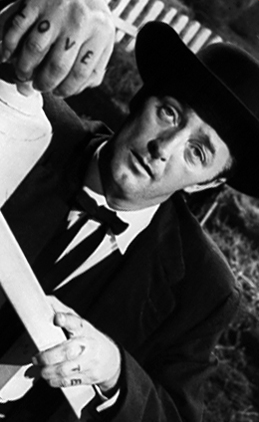
The frightening story is told partially from the point of view of small children. Hiding behind his Bible, serial killer Harry Powell charms Willa Harper (Shelley Winters), hoping to discover where her dead husband hid $10 thousand in stolen money. Soon after their marriage, Powell sets to extracting the secret of the money from Willa's children. Tiny Pearl (Sally Jane Bruce) is willing to accept her new daddy, but the older John (Billy Chapin) sees through Powell's deception and holds firm. Nobody is on John's side. His mother thinks he's holding on to his father's bad example, and the nosy Icey Spoon (Evelyn Varden) considers John a bad boy who "needs a dose of salts". The unenthusiastic advertising campaign for The Night of the Hunter promised a racy thriller. The few ticket buyers must have been surprised to find an arty concoction stacked with exaggerated sets and stylized performances, and it disappeared from screens almost immediately. Long a buried cinematic treasure, the film now excites and energizes audiences with its nonconformist artistry. Filmmaker Spike Lee appropriated the film's show-stopping set piece, Harry Powell's insultingly simplistic dramatization of the conflict between good and evil using the words "Love" and "Hate" tattooed on his fingers. But no film has come near Laughton and production designer Hilyard Brown's stylized representation of Depression-era Ohio. The dreamlike nighttime landscape is represented by artificial cutout hills and twinkling stars that resemble graphics from a child's story book. The frame house of the newly widowed Willa Harper (Shelley Winters) appears to be only a few feet deep, while an entire neighboring farm is rendered in only two dimensions, like a child's diorama. The film's daytime scenes are more realistic yet present equally disturbing social content.1950s audiences weren't accustomed to images of hungry orphans begging door to door for castoff potatoes, or small children threatened by a sex murderer. The movie also dares to present down-home religion as essentially malign, an influence for conformism and hypocrisy. 1 The movie evokes comparisons with classic cinematic forms but doesn't fully align with any of them. One acknowledged influence is the silent classics of D.W. Griffith, as seen in the harmonious pictorials of the film's farm scenes and the presence of Griffith's iconic star Lillian Gish. Cinematographer Stanley Cortez ends one scene with a classic Griffith iris transition, performed in-camera. Yet the movie also uses helicopter shots, which in 1955 were not the norm in Hollywood fare. Laughton contrasts his bucolic daylight images with elements more at home in expressionist horror. Harry Powell's hulking silhouette is a Caligari- like nightmare, whether looming on a hilltop or drifting across the screen on the back of a mule, singing a hymn. The Harper basement becomes a pit surrounded by darkness and connected to reality by a diagonal staircase. When Harry is overtaken by the rapture of the "religion that God and me worked out betwixt us", Willa's bedchamber transforms into a perverse church, complete with a steeple formed by stabbing slivers of light. 2 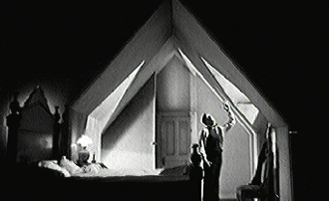
The Night of the Hunter's stylized performances also take audiences by surprise. Robert Mitchum is amazing as the insane Harry Powell, who charms women with his romantic good looks and silences critics with his false piety. The more outrageous the charlatan's holy talk, the more the unthinking faithful accept him. Evelyn Varden's wickedly accurate Icey Spoon is a domineering church matron whose pea-brained endorsement enables Powell to do his dirty work. Powell need only bat his eyes at the love-starved Ruby (Gloria Castilo) and she'll do whatever he wants. Little Pearl (Sally Jane Bruce) is Powell's toughest conquest -- he never quite undermines Pearl's loyalty to her brother John (Billy Chapin) and must finally resort to threats of violence. These scenes were surely a major turn-off for the '50s audience. Filmmakers tread on thin ice when they put children in jeopardy, and five year-old Sally Jane appears genuinely surprised when Mitchum talks tough and flicks a switchblade right in front of her nose. What kind of stage mother would trust her child with Hollywood's most unpredictable bad boy? The most disturbing content comes straight from Davis Grubb's novel. Harry Powell psychologically torments Willa Harper with guilt for her dead husband's crimes and shame for her own "filthy" sexuality. Numbed into submission and deprived of her better judgment, Willa denies obvious evidence of her new husband's murderous intentions. She instead accepts Powell as her savior and retreats into a fantasy of religious harmony. The film's mix of sex, violence and religious hysteria is potent stuff. 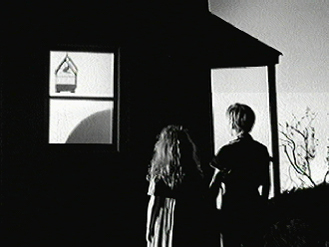
Charles Laughton's scathing criticism of "old time religion" as a repressive source of evil doesn't stop with the character of Harry Powell. The sanctimonious Icey Spoon and her self-righteous ilk are easily converted into a drunken lynch mob. This assault on degraded religious values might have attracted controversy had audiences seen The Night of the Hunter in large numbers. It was in fact rejected for exhibition in some parts of the South. The film's positive alternative to revivalism is Miss Cooper's home-based Bible teaching. Cooper forgoes paternal authoritarianism and instead teaches by example, stressing the positive values of understanding and forgiveness. She can be a nag but she also possesses natural wisdom. When her errant ward Ruby tearfully confesses that she's been skipping sewing lessons to "go with men", Miss Cooper offers sympathy, not condemnation or guilt: "You were just looking for love, Ruby, in the only foolish way you knew how". The Night of the Hunter creates its own cosmos, with an absent father, a protective mother figure and a horrid devil. In the film's most inspired sequence the children flee from Powell in a small boat and find a brief respite suspended between twinkling stars and the dark river. A host of nocturnal animals watch them from the riverbanks. Are the rabbits, frogs and turtles there to protect the fugitives, or do they represent an indifferent nature? John and Pearl are ill equipped to survive in this uncivilized wilderness, but their spiritual innocence forms a momentary shield from fear. Pearl sings a beautiful, eerie tune that appears to transport their skiff past the spider's web and away from Powell, to safety. Her song makes the night bearable. 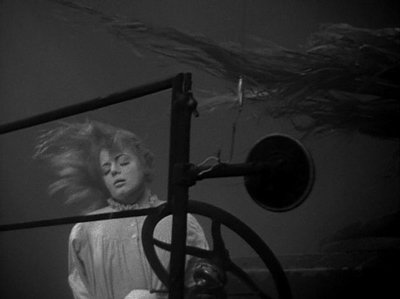
Producer Paul Gregory remembers that United Artists took one look and decided that Laughton's film was too arty to be a commercial contender. They were right in a broad sense, but a customized art-film release could have turned the movie into an "event" picture. From the middle 1930s on United Artists became the distributor of many independent productions, often films with content deemed uncommercial, whether politically controversial (So Ends Our Night), socially critical (The Underworld Story) or stylistically radical (Kiss Me Deadly). Charles Laughton was reportedly deeply discouraged by the commercial failure of his labor of love, which found recognition as a classic only long after he was gone. Criterion's two-disc Blu-ray of The Night of the Hunter completely eclipses MGM's DVD from 2000. The full restoration and digital cleanup treatment given this marvelously filmed B&W show results in something beautiful to behold. We feel we can reach out and touch Jack Rabin's painted moon, and the contrast between the "Griffith" farm scenes and the "Caligari" night scenes is even more acute. Expect some web grousing about the transfer's chosen aspect ratio, an absolutely correct, slightly matted widescreen 1.66:1. This wasn't done to fill HD monitors but to honor the film's original screen shape. Viewers accustomed to flat TV prints and videos will miss two or three bravura shots -- the wider view of the basement, the murder scene in the vaulted-ceiling bedroom -- that looked even more radical when projected full-frame. But the rest of the movie has plenty of dead space above and below, and for one interior night farm scene an open matte peers right over the top of the cyclorama backing, into the rafters of the sound stage. Criterion has chosen the right scan for their transfer. 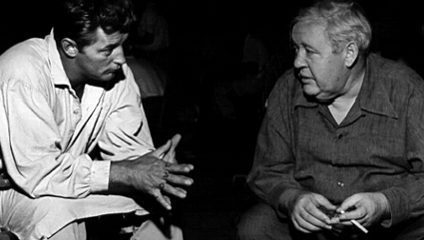
The feature comes with a composite commentary featuring input from critic F.X. Feeney, author Preston Neal Jones, and The Night of the Hunter's second unit director Terry Sanders. UCLA Film Archives' restoration expert Robert Gitt is also present on the track. Criterion disc producer Issa Clubb includes plenty of rare prime-source extra content. A new documentary combines film clips and photos with the recollections of producer Paul Gregory to present a full picture of the film's production. In a new interview, Charles Laughton biographer Simon Callow discusses The Night of the Hunter in terms of its director, making the case that Laughton's awareness of the persecution of gays contributed to the film's critical look at religious hypocrisy. A 1995 BBC introduction to the movie features interviews with the late actors Robert Mitchum, Shelley Winters and Lillian Gish. It shows how misinformation can become history when Mitchum incorrectly asserts that Laughton didn't use much of screenwriter James Agee's work. Cinematographer Stanley Cortez is given his own video showcase in a 1985 French TV interview filmed at the A.S.C.'s Hollywood clubhouse. Also included are author Davis Grubb's concept sketches and a clip fromThe Ed Sullivan Show with Peter Graves and Shelley Winters performing a scene cut from the movie. The film's ineffective, forgettable original trailer is also included. Criterion's second Blu-ray disc makes The Night of the Hunter the year's most intriguing video release, bar none. It contains Charles Laughton Directs "Night of the Hunter", archivist Robert Gitt's eye-opening 150-minute presentation that until now has been screened only under special circumstances. Several decades ago Laughton's widow Elsa Lanchester turned over to Gitt hours of film kept by her husband, 35mm daily rolls of picture and audio. The outtakes document the entire filming, showing Laughton's impressive directing style in full detail. It's fascinating to hear him shape the performances by leaving the camera running while he coaches his actors. Laughton has the confidence of his cast and is especially good at obtaining precise performances from his child actors. Young Billy Chapin comes off as a responsive professional and the 5 year-old Sally Jane Bruce exhibits remarkable concentration under Laughton's sensitive, nurturing direction. Laughton is harsher with Shelley Winters but this seems a method of helping her maintain a certain level of anxiety. Neither actor nor director loses concentration or shows any irritation. Asked to say a quick prayer before one of her revival speeches, Ms. Winters blurts out what sounds like a line of Hebrew! But nobody laughs, as this is serious business. 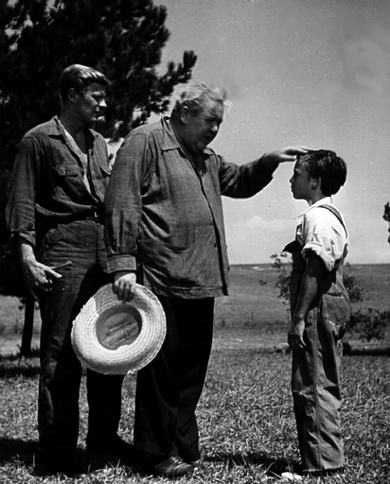
The two hours of dailies never become tedious. We see one older actor replaced and watch many Lillian Gish outtakes where she's more conventionally sentimental than she appears in the final film. When Evelyn Varden recites her dicey dialogue about sex with her husband, we see a variety of Don Beddoe's humiliated reactions, while Ms. Varden tries her best to conceal her awareness of the sly joke during stage waits, after "cut" is called. The biggest surprise of the dailies is Robert Mitchum, who has his character down pat at all times and receives little or no verbal direction from Laughton. Mitchum is professional with the kids and gentle with little Sally Jane -- no matter how threatening he becomes, she just keeps staring at him with her saucer eyes. Respecting the children and his director, Mitchum at one point seems to catch himself before saying something profane. Like everyone else, he gives a big performance and relies on Laughton to tame it down later. His famous scream in the river seems to have been created in post-production. In dailies, Mitchum shouts out short barking noises instead of a long, Edvard Munch-like scream. Perhaps Mitchum saw his character as sort of a demonic, cowardly animal? Robert Gitt also leaves room for clips of the film's excellent special effects by Louis De Witt and Jack Rabin. We see individually filmed animals and a fake spider's web combined optically for the river escape scene. Several nearly undetectable mattes combine sets and twinkling stars, and add a Mississippi riverboat to a scene filmed in Southern California. For its contribution to cinema history, Criterion's The Night of the Hunter Blu-ray is the outstanding home video release of the year.
On a scale of Excellent, Good, Fair, and Poor,
The Night of the Hunter Blu-ray rates:
Footnotes:
1. Frankly, in the conformist Hollywood of 1955, that Davis Grubb's disturbing book could be filmed at all is highly unusual. Sixteen years later Columbia Pictures produced Grubb's Fool's Parade, an anarchic tale of a Depression-era prisoner swindled by corrupt prison officials and bank managers. The adaptation casts James Stewart as the dynamite tossing terrorist hero, but is careful to resolve all class and economic differences by the fade-out. The social evil is redefined and isolated in a solitary banker and a bad-apple prison guard. Stewart's one-eyed revenging geezer goes soft at the conclusion, and counsels his young partner in crime (Kurt Russell) to settle down to boosh-wah happiness with an apple-cheeked girlfriend. Hey Hollywood, this is the kind of movie that mertis a remake!
2. Some will see it as a generic theatrical gesture, but when Sondheim's Sweeney Todd reaches his arm up to the light holding his razor to revel in his "delicious evil", to me it's always seemed inspired by Robert Mitchum making his hand into a claw and holding it up to the moonlight, as if receiving divine inspiration to kill. The moment in Night of the Hunter is twice as powerful because it is Robert Mitchum doing the 'artsy' expressionist performing chores. Who would have thought that the original Mr. Slouch, the "I don't care" guy, was into poetry and art filmmaking?
Reviews on the Savant main site have additional credits information and are often updated and annotated with reader input and graphics. Also, don't forget the 2010 Savant Wish List. T'was Ever Thus.
Review Staff | About DVD Talk | Newsletter Subscribe | Join DVD Talk Forum |
| ||||||||||||||||||